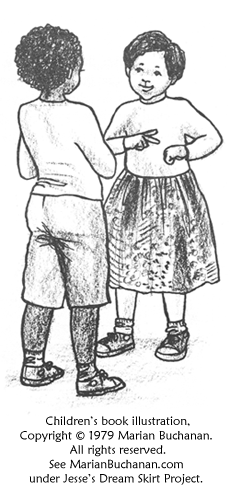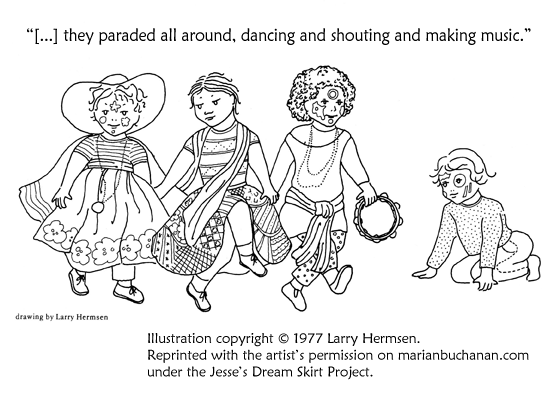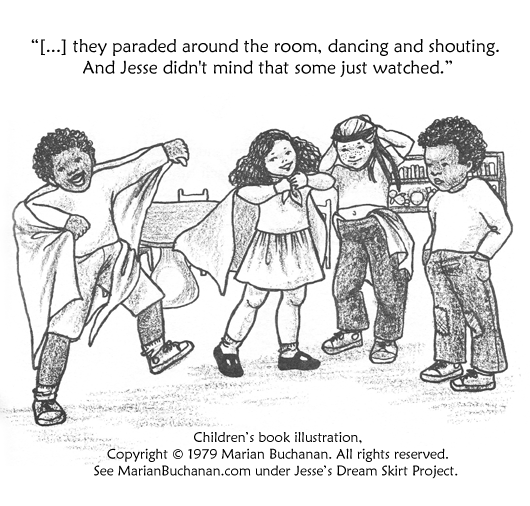Joining in (or not)
 This is a continuation of the exploration of the differences between the two versions of the children’s story, Jesse’s Dream Skirt. I’ve covered the daycare children’s initial reactions and then the group discussion initiated by the teacher. Now let’s find out what happens next.
This is a continuation of the exploration of the differences between the two versions of the children’s story, Jesse’s Dream Skirt. I’ve covered the daycare children’s initial reactions and then the group discussion initiated by the teacher. Now let’s find out what happens next.
In both versions, the discussion ends on a note that makes Jesse feel better. In the magazine version, after Sarah calls him brave, he looks around and sees “everyone smiling.” It’s not a realistic scenario, since it would likely take more than what Sarah said to convert the naysayers in the group. In the book version, though, the discussion ends with “so many of the children” talking at once that Jesse can’t tell who’s saying what, but everything he hears is positive.
In both versions, it’s at this point that he tells the children about his dream and how he and his mother made the skirt.
In the magazine version, the teacher then reminisces about how he, too, liked to wear a skirt when he was little, but “became afraid after hearing everyone ridicule [him]” and therefore stopped wearing it outside. (This harkens back to this version’s focus on messages about fear and courage: Jesse’s mother thinks he’s “strong” for wearing his dream skirt to daycare and Sarah thinks he’s “brave.”)
After giving this confession of sorts, the teacher goes over to a box of material and makes “a loose skirt out of some bright fabric.” Even though it’s not said, one can get the impression that he’s making up for his past fear by daring to assert his freedom to wear a makeshift skirt now. And yes, it also demonstrates him making it easier for the children to do the same if they wish.
The teacher’s memories, and the light they cast on his decision to wear a makeshift skirt in this moment, complicate the exploration of the issues and muddy the waters about how and why an adult might respond to a child in their care crossing a line that is purely (and benignly) cultural.
In the book version, the omission of the teacher’s story avoids entangling an adult’s personal history with the child’s current situation. The teacher still goes to the box of fabric to choose a piece of cloth to wrap around his waist “like a loose skirt,” but there is no sense of it being done out of anything but a desire to diffuse the tension for the children’s sake and demonstrate that it’s okay for boys and men to wear skirts. This does indeed help make the act “okay” for the children to do as well, and both boys and girls get involved in following the teacher’s lead.
In the magazine version, the description of the fabric part of the dress-up fun is limited to them “trying on all sorts of things,” whereas in the book version there is a more detailed description of the ways the children get creative with turning fabric into skirts, capes, turbans, and headbands.
In the earlier version, some of them paint their faces or their bodies, while others just watch. It’s not clear whether the watchers are non-participant only in the painting or also in the dressing up. It’s also not clear whether they’re still just watching when the children are described as “all” looking “beautiful to one another as they paraded all around, dancing and shouting and making music.”

In the book version, there’s no painting, as the focus is still on the freedom to wear any clothes (or cloth) one wishes, regardless of sex or gender. There is, however, a spontaneous parade around the room, dancing and shouting. But Jesse is the one who is described as thinking everyone looks beautiful in their makeshift outfits, because in this version of the story, the message is not about everyone ending up smiling and thinking everyone else is beautiful – in other words, the naysayers changing their mind. On the contrary, in this version, it’s clear that not everyone is participating, and this is not only more realistic, it also allows it to be said that “Jesse didn’t mind that some just watched.”
In other words, this is not about converting anyone. This is simply about being free to be how one is oneself.

That concludes the coverage of how the children are depicted in the two versions of Jesse’s Dream Skirt. There’s still a lot more to explore in the comparison of the versions, as well as interesting glimpses into the making of the book illustrations and other related topics, so… stay tuned for future posts in the series!
And in the meantime, as always, please feel welcome to let me know what you think.
